Well beyond its first successful demonstration in 1960, the laser has found its way into applications that are the stuff of Hollywood movies — and into the movie theater, too.
Sixty years ago, physicists Charles Hard Townes, James P. Gordon and H.J. Zeiger demonstrated the maser (microwave amplification by stimulated emission of radiation). It wasn’t long before Townes and fellow physicist Arthur Schawlow proved that masers could be made to operate in the visible and infrared regions. Around the same time, research by Gordon Gould, then a graduate student at Columbia University, found that a concentrated beam of light could push technology beyond the maser, and coined his concept the laser — for light amplification by stimulated emission of radiation. In 1960 — based on theoretical work by Townes, Schawlow and Gould — engineer and physicist Theodore H. Maiman built and demonstrated the first working example.
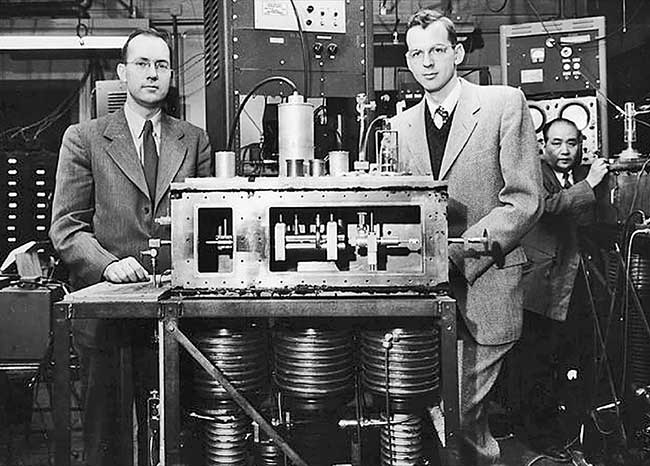
Charles Hard Townes (left) is pictured in 1954 with the maser he developed with then-graduate student James P. Gordon (right) and then-postdoctoral researcher H.J. Zeiger (not shown). The device radiated at a wavelength of a little more than 1 cm and generated approximately 10 nW of power. Courtesy of Smithsonian Institution.
The technology advanced quickly after that first ruby laser, and applications soon followed. For decades, lasers have been finding new applications, from consumer electronics to global telecommunications, industry, science and medicine. Now, they are reaching new heights in aerospace and enhancing the movie experience.
Look, up in the sky!
The first laser-powered aircraft took to the skies in 2003. Developed by a team from NASA’s Marshall Space Flight Center, the Dryden Flight Research Center and the University of Alabama in Huntsville, the plane was powered by an invisible ground-based laser that was tracking the aircraft in flight, and directing its energy beam at specially designed photovoltaic cells carried onboard to power the plane’s propeller.
In the years since this development, lasers have become a versatile tool for aerospace applications. Among them, according to Laserage Technology Corp. — a laser component manufacturer in the medical and aerospace industries — is hermetic laser sealing of electronic and optoelectronic packages on spacecraft to protect such systems. Employing laser processing (e.g., welding, drilling and coating) in the aerospace industry provides flexibility in design and manufacturing, resulting in lighter components and, potentially, reduced costs.
Laser frequency combs are another technology shown to advance aerospace applications. Created by a laser that emits continuous pulses of light spanning almost the entire visible spectrum, these combs are used for precisely measuring the frequency of light from a variety of sources. This technology also helps telescopes achieve unprecedented accuracy in spectral measurements.
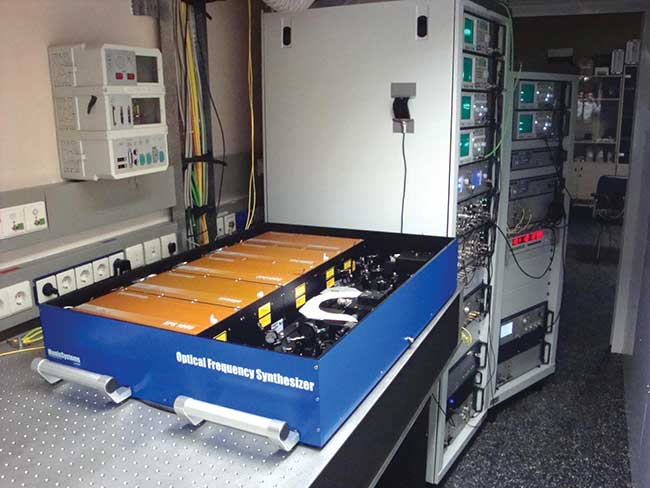
A laser frequency comb. Courtesy of Rafael Probst.
A team from three German institutions — the Max Planck Institute of Quantum Optics, the Kiepenheuer Institute for Solar Physics, and the University Observatory Munich — led the research. By attaching a laser frequency comb to the Kiepenheuer solar telescope in Tenerife in the Canary Islands, light from both the comb and the sun was coupled to a single optical fiber connected to a spectrograph.
“An important aspect of our work is that we use a single-mode fiber, which takes advantage of the wave nature of light to enable a very clean and stable beam at its output,” said Rafael Probst, a post-doctoral candidate at the Max Planck Institute of Quantum Optics. “This type of fiber is quite common in telecom and laser applications, but its applications in astronomy are still largely unexplored.”
The laser frequency comb technique has been shown to improve calibration by about a factor of 100 over a temporally separated fiber transmission. In combination with this calibration, the laser frequency comb method enables extremely robust and accurate spectroscopic measurements. This technology could allow astronomers to more accurately measure a planet’s Doppler shifts, essentially increasing the chance of spotting Earth-sized, habitable planets, and additionally enabling better study of the sun, distant stars and exoplanets.
NASA is looking beyond Earth’s orbit also with its Lunar Laser Communication Demonstration (LLCD). In it, the Lunar Atmosphere and Dust Environment Explorer (LADEE) spacecraft orbiting the moon has been able to downlink data to two receiver terminals using a laser beam. While the organization communicates with its spacecraft primarily via radio waves, the Deep Space Network (DSN) relies on large antenna arrays around the globe. Engineers are working to switch to optical frequencies instead, according to Francesco Marsili, a microdevices engineer at NASA’s Jet Propulsion Laboratory. This would increase the data rate of the communication links, and rely on technology such as lasers mounted to the spacecraft that are pointed at optical telescopes on Earth to downlink data.
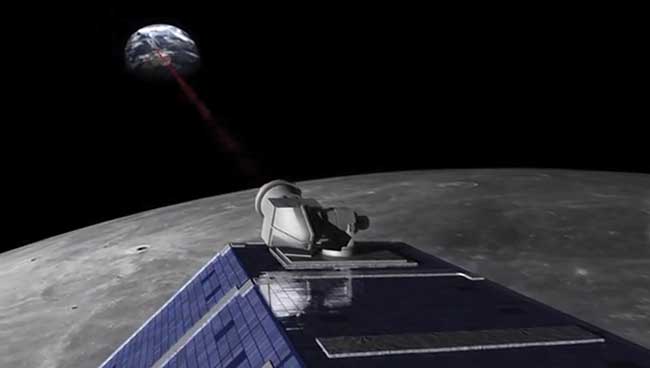
An artist’s concept of NASA’s Lunar Atmosphere and Dust Environment Explorer (LADEE), showing the Lunar Laser Communications Demonstration (LLCD). Courtesy of NASA.
“With the huge quantities of data from missions that are going farther and farther away from the Earth, we need higher bandwidth communications systems,” said Chip Barnes, chief engineer for the Ball Aerospace Civil Space business unit. Advancing such communications systems will require further development of optics and photonics technologies, and more efficient lasers.
Battling biological agents
Bioweapons are a growing concern among military leaders. In Canada, they are taking a proactive approach to such threats.
The Defence Research and Development Canada (DRDC) Valcartier, a government agency, is currently seeking to investigate how lasers could help detect airborne biological and chemical agents, and ultimately offer early warning of these types of weapons. According to a request for proposals filed in September, DRDC is dedicating $850,000 to this project, which will involve studying “the phenomenology of the optical and infrared signals from chemical and biological material” to be able to “process and analyze these signals from acquired data set during either field trial, including aerial, or laboratory data acquisition campaign.”
The U.S. military is studying the use of lasers, as well, but for advancement of fighter jets and similar aircraft (for the detection of weapons, bombs and other potential threats). The Air Force Special Operations Command has been moving toward installation of a high-energy laser and tactical off-board sensors to an AC-130W gunship on military fighter jets. The request for funding (from the Department of Defense) for this research has been made, according to information from FlightGlobal — an agency that provides data, insight and other services for the aviation industry — and the work could begin by 2020.

A U.S. Air Force AC-130W gunship. Courtesy of U.S. Air Force.
Multimedia lasers: from Wi-Fi to the movies
Laser weapons were once only the stuff of movies and television. Now, lasers are becoming part of the picture in applications from data communications and lighting to projection. In this increasingly digital age, users are constantly looking for better, faster wireless connectivity. Wi-Fi and Bluetooth, both well-established technologies, already offer high speed, but now scientists are seeing room to grow.
A team from the King Abdullah University of Science & Technology (KAUST) in Saudi Arabia has demonstrated that white light from lasers could provide data speeds up to 2 GB/s. To do this, they have developed a way to shorten the wavelength of the electromagnetic waves used for transmitting information — a nanocrystalline material that rapidly makes white light out of blue light. Parts of the electromagnetic spectrum that are unregulated and more energy-efficient are used for visible light communication (VLC), thus producing white light.
“VLC using white light generated in this way is limited to about one hundred million bits per second,” said Boon Ooi, a professor of electrical engineering at KAUST.
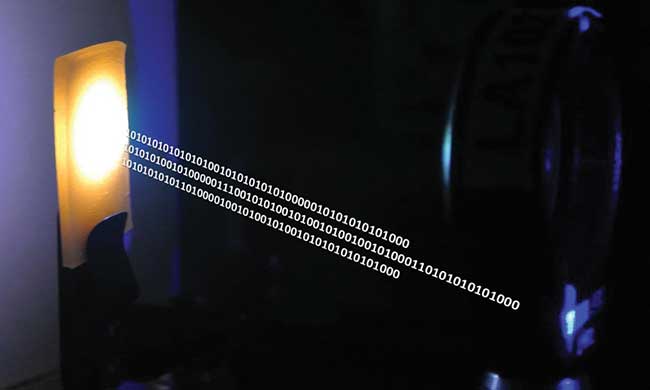
A nanocrystal-based material converts blue laser emission to white light for combined illumination and data communication. Courtesy of King Abdullah University of Science & Technology.
To clear this hurdle, the researchers employed a solution-based method that incorporated a conventional nitride phosphor to develop nanocrystals made from cesium lead bromide. When illuminated by a blue laser light, the nanocrystals emitted green light and the nitride emitted red light; combined, the two produced a warm white light. The white light generated “was of a quality comparable to present LED technology,” according to the researchers. So in addition to faster Wi-Fi, they have found that such light could have another use.
“We believe that white light generated using semiconductor lasers will one day replace the LED white light bulbs for energy-efficient lighting,” Ooi said.
And while lasers still aren’t recommended for popping popcorn, you can now find them at the movies.
Developed jointly by Dolby Laboratories, Christie Digital and Necsel, the Dolby Vision Cinema Laser Projector — winner of the 2016 Prism Award for Displays and Lighting — is set to enhance the “premium cinema experience with high contrast, high brightness, a wide color gamut and excellent 3D performance,” and make it more engaging for viewers.
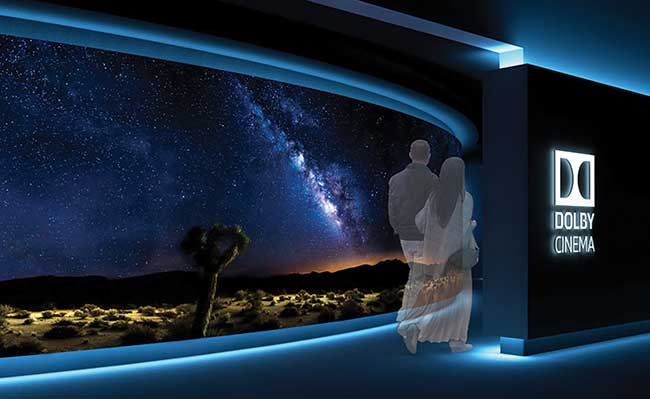
The Dolby Vision laser projection system is set to enhance the cinema experience, and make it more engaging for moviegoers. Courtesy of Christie Digital.
“Cinema projection does not get any better than this,” said Don Shaw, senior director of product management at Christie.
The system employs optics and image processing for high dynamic range, and enhanced color technology provides a high-contrast, high-brightness color range that matches what is visible to the human eye. The technology uses two high-frame-rate-capable 4K laser projection heads (by Christie), featuring a customized light path. Combined with a 6P modular laser light source, the laser system creates high-contrast images and ultra brightness. According to Necsel, the system provides “strikingly vivid and realistic images, and makes viewers feel like they are in the movie’s world.”
“We’ll be delivering audiences a richer, more detailed viewing experience with up to 14 foot-lamberts on-screen in 3D and up to 31 foot-lamberts for 2D Dolby Vision content,” Shaw said, noting that this exceeds ultra-bright industry standards.